
A centimetre or centimeter is a unit of length in the metric system, equal to one hundredth of a metre, centi being the SI prefix for a factor of 1/100. The centimetre was the base unit of length in the now deprecated centimetre–gram–second (CGS) system of units.
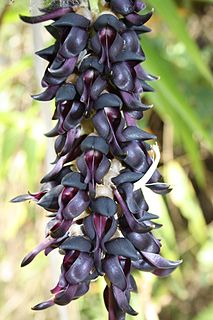
Mucuna pruriens is a tropical legume native to Africa and tropical Asia and widely naturalized and cultivated. Its English common names include monkey tamarind, velvet bean, Bengal velvet bean, Florida velvet bean, Mauritius velvet bean, Yokohama velvet bean, cowage, cowitch, lacuna bean, and Lyon bean. The plant is notorious for the extreme itchiness it produces on contact, particularly with the young foliage and the seed pods. It also produces many medium-sized red swollen across your contact area of skin that is actively itchy. It has agricultural and horticultural value and is used in herbalism.

Dracophyllum is a genus of plants belonging to the family Ericaceae, formerly Epacridaceae. There are some one hundred or so species in the genus, mostly shrubs, but also cushion plants and trees, found in New Zealand, Australia, Lord Howe Island and New Caledonia. The name Dracophyllum, meaning dragon-leaf, refers to their strong similarity to the unrelated Dracaena, sometimes known as dragon tree. Although dicotyledonous, they resemble primitive monocots with their slender leaves concentrated in clumps at the ends of the branches; they are sometimes called grass-trees.

Selenocosmia crassipes, synonym Phlogius crassipes, also known as the "Queensland whistling tarantula" is a species of tarantula native to the east coast of Queensland, Australia. The name "whistling tarantula" comes from its ability to produce a hissing noise when provoked, a trait it shares with other Australian theraphosids. This hissing is produced by the spider stridulating a patch of setae associated with its chelicerae. It has also been called the "eastern tarantula". The species name crassipes is Latin for "fat leg" referring to the relatively fat front legs.
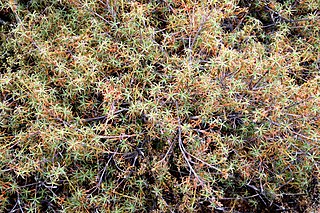
Dracophyllum recurvum, known commonly as curved leaf glass tree or neinei is a prostrate to semi-erect shrub belonging to the genus Dracophyllum.

Desmanthus leptolobus, known as prairie mimosa, prairie bundleflower or slenderlobe bundleflower, is a flowering plant of the genus Desmanthus. It is native to Kansas, Oklahoma, and Texas and has spread to Missouri and New Mexico. It is often locally abundant over large expanses of rolling prairie.

Kennedia rubicunda, commonly known as the dusky coral pea, is a species of flowering plant in the family Fabaceae, endemic to Australia. It occurs in the states of Victoria and New South Wales and Queensland.

Dracophyllum milliganii is a species of flowering plant in the family Ericaceae. It is endemic to Tasmania.

Dracophyllum secundum is a prostrate to semi-erect shrub found in eastern Australia. It occurs from as far south as Pigeon House Mountain north to Kendall, New South Wales on the mid north coast. A common plant in the Blue Mountains near Sydney. Found as far west as Blackheath. It is often noticed by bushwalkers for the attractive flowers and arching foliage. The specific epithet secundum means "arranged on one side only".

Grevillea parallela, also known as silver oak, beefwood or white grevillea, is a tree native to northern Australia.

Dracophyllum longifolium, commonly called inaka, is an upright shrub or small tree in the family Ericaceae that is endemic to New Zealand.
Hollandaea is a genus of four species known to science, of Australian rainforest trees, constituting part of the plant family Proteaceae.
Hollandaea sayeriana, sometimes named Sayer's silky oak, is a small species of Australian rainforest trees in the plant family Proteaceae.

Dracophyllum fitzgeraldii, commonly known as the Fitzgeraldii tree or Fitzgerald tree, is a flowering plant in the family Ericaceae. The specific epithet honours Robert Fitzgerald, an Irish–Australian surveyor and botanist who collected plants on Lord Howe Island in 1869. Its closest relatives are species native to northern Queensland and to New Caledonia.

Acacia calcicola is a shrub or tree of the genus Acacia and the subgenus Plurinerves that is native to parts of central Australia. Common names for this species include; shrubby wattle, shrubby mulga, myall-gidgee, northern myall and grey myall. Indigenous Australians the Pitjantjatjara peoples know the tree as ikatuka, the Warlpiri know it as jirlarti and the Arrernte know it as irrakwetye.
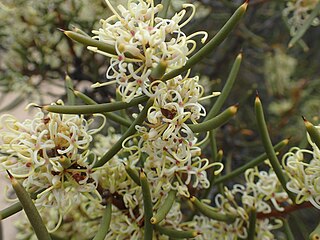
Hakea preissii, commonly known as the needle tree, needle bush and Christmas hakea, is a shrub or tree of the genus Hakea native to Western Australia. The Noongar name for the plant is Tanjinn.
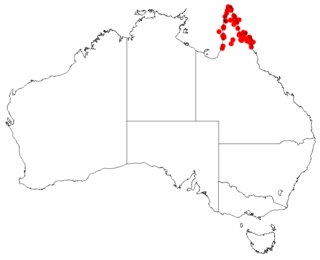
Hakea pedunculata is a shrub or small tree of the genus Hakea comprising approximately 150 species restricted to Australia. This species is found in the Far North region of Queensland and adjacent islands. Most Hakea seed are usually dispersed by an environmental trigger rather than when seed matures, quite often by fire. Whilst other species may require sporadic flooding rains to establish.

Grevillea decora is a shrub of the genus Grevillea native to an area in the Great Dividing Range of Queensland.
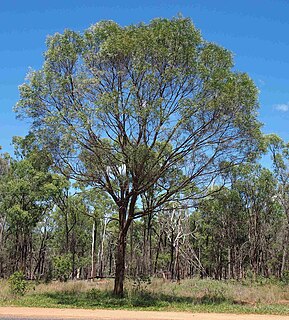
Acacia shirleyi, known colloquially as lancewood, is a species of Acacia native to Queensland and the Northern Territory in Australia. It grows as a tree to 15 metres (49 ft) high, with dark grey or black stringy bark and blue-grey foliage. The yellow flowers appear from March to July. It grows in dry scrub, open forest or mixed savannah woodland. Indigenous people used the wood as fuel and to make hunting spears. Cattle can eat the foliage as fodder.

Hakea persiehana is a shrub or small tree in the genus Hakea, which comprises approximately 150 species restricted to Australia. Most Hakea seed are usually dispersed by an environmental trigger rather than when seed matures, quite often by fire, whilst other species may require sporadic flooding rains to establish. Hakea is within the family Proteaceae


















